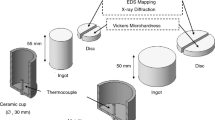Abstract
Current Al alloys still have shortcomings in their volumetric latent heat (LHV), compatibility and high-temperature inoxidizability, which limit their applications in the field of latent heat energy storage (LHES). The performance of aluminum alloys can be improved by the addition of Cu. The effects of the Cu content on the phase change temperature, mass latent heat (LHM), LHV, supercooling degree and microstructure of Al–Cu alloys were first studied by means of power-compensated differential scanning calorimetry, density, composition analysis and metallographic analysis. The measured values of the latent heat of Al–Cu alloys have been compared with the theoretically predicted values. The results show that for Al–Cu alloys with 7.3–52.8% Cu, the melting/freezing temperature is 540–655 °C/510–637 °C; the LHM and the LHV are 290–340 J g−1 and 877–1224 J cm−3, respectively; and the degree of supercooling is within 10 °C. The LHM and LHV of Al–Cu alloys decrease with the increase in the Cu content; when the content of Cu is over 16.6%, the difference between the theoretical value of the LHM and the measured average of the Al–Cu alloys is within 5%. The LHES phases in Al–Cu alloys are the α-Al and theta phases. Quantitative relationships of the Cu content and metallurgical microstructure with the LHM and LHV of Al–Cu alloys are established, and both theoretical and empirical equations are obtained for the estimation of the latent heat for Al–Cu alloys.





Similar content being viewed by others
References
Yuan YP, Zhang N, Tao WQ, Cao XL, He YL. Fatty acids as phase change materials: a review. Renew Sustain Energy Rev. 2014;29(7):482–98.
Jeon J, Lee JH, Seo J, Jeong SG, Kim S. Application of PCM thermal energy storage system to reduce building energy consumption. J Therm Anal Calorim. 2013;111(1):279–88.
Dan NN, Haghighat F. Thermal energy storage with phase change material—a state-of-the art review. Sustain Cities Soc. 2014;10:87–100.
Yuan Y, Gao X, Wu H, Zhang Z, Cao X, Sun L, et al. Coupled cooling method and application of latent heat thermal energy storage combined with pre-cooling of envelope: method and model development. Energy. 2016;. doi:10.1016/j.energy.2016.11.058.
Kenisarin M. High-temperature phase change materials for thermal energy storage. Renew Sustain Energy Rev. 2010;14(3):955–70.
Pielichowska K, Pielichowski K. Phase change materials for thermal energy storage. Prog Mater Sci. 2014;65(10):67–123.
Kenisarin M, Mahkamov K. Solar energy storage using phase change materials. Renew Sustain Energy Rev. 2007;11(9):1913–65.
Wei G, Xing L, Du XZ, Yang Y. Research status and selection of phase change thermal energy storage materials for CSP systems. Proc CSEE. 2014;34(3):325–35.
Yuan Y, Li T, Zhang N, Cao X, Yang X. Investigation on thermal properties of capric–palmitic–stearic acid/activated carbon composite phase change materials for high-temperature cooling application. J Therm Anal Calorim. 2016;124:881–8.
Ge H, Li H, Mei S, Liu J. Low melting point liquid metal as a new class of phase change material: an emerging frontier in energy area. Renew Sustain Energ Rev. 2013;21(5):331–46.
Kotzé JP, Von Backström TW, Erens PJ. High temperature thermal energy storage utilizing metallic phase change materials and metallic heat transfer fluids. J Sol Energy Eng. 2013;135(3):38–42.
Gokon N, Nakamura S, Yamaguchi T, Kodama T. Cyclic properties of thermal storage/discharge for Al-Si Alloy in vacuum for solar thermochemical fuel production. Energy Procedia. 2015;69:1759–69.
Sun JQ, Zhang RY, Liu ZP, Lu GH. Thermal reliability test of Al–34%Mg–6%Zn alloy as latent heat storage material and corrosion of metal with respect to thermal cycling. Energy Conv. 2007;48:619–24.
Wang Z, Wang H, Li X, Wang D, Zhang Q, Chen G. Aluminum and silicon based phase change materials for high capacity thermal energy storage. Appl Therm Eng. 2015;89:204–8.
Farkas D, Birchenall CE. New eutectic alloys and their heats of transformation. Metall Trans A. 1985;16(3):323–8.
He F, Chao S, He X, Li M. Inorganic microencapsulated core/shell structure of Al–Si alloy micro-particles with silane coupling agent. Ceram Int. 2014;40(5):6865–74.
Yousaf M, Iqbal J. Characterization of steel 1035 hot-dip-aluminized in pure Al and Al–Cu alloys. Mehran Univ Res J Eng Technol. 2010;29(2):327–36.
Liu H, Bouchard M. Evaluation of interaction coefficient in Al–Cu–H alloy. Metall Mater Trans B. 1997;28(4):625–32.
Birchenall CE, Riechman AF. Heat storage in eutectic alloys. Metall Trans A. 1980;11(8):1415–20.
Kuravi S, Trahan J, Goswami DY, Rahman MM, Stefanakos EK. Thermal energy storage technologies and systems for concentrating solar power plants. Prog Energy. 2013;39(4):285–319.
Gasanaliev AM, Gamataeva BY. Heat-accumulating properties of melts. Russ Chem Rev. 2007;69(2):179–86.
Mills KC. The heat capacity of Cu+Al alloys. J Chem Thermodyn. 1977;9(1):43–53.
Quaresma JM, Santos CA, Garcia A. Correlation between unsteady-state solidification conditions, dendrite spacings, and mechanical properties of Al–Cu alloys. Metall Mater Trans A. 2000;31(12):3167–78.
Murray JL. The aluminium–copper system. Int Metals Rev. 1985;30(1):211–34.
Okamoto H. Desk handbook phase diagrams for binary alloys. Materials Park: ASM International; 2000.
Zhang Y, Su Y, Ge XJ. Prediction of the melting temperature and the fusion heat of (quasi-) eutectic PCM. China Univ Sci Technol. 1995;25(4):474–8.
Wang X, Liu J, Zhang Y, Jiang DY. Experimental research on a kind of novel high temperature phase change storage heater. Energy Conv. 2006;47(15–16):2211–22.
Maruoka N, Akiyama T, Sato K, Yagi J. Development of PCM for recovering high temperature waste heat and utilization for producing hydrogen by reforming reaction of methane. ISIJ Int. 2002;42(2):215–9.
Callister WD, Callister WD. Fundamentals of materials science and engineering. Hoboken: Wiley; 2008. p. 824.
Acknowledgements
This research was financially supported by the Natural Science Foundation of China (51378426), the Sichuan Province Youth Science and Technology Innovation Team of Building Environment and Energy Efficiency (2015TD0015), and the Fundamental Research Funds for the Central Universities (2682015CX038).
Author information
Authors and Affiliations
Corresponding author
Rights and permissions
About this article
Cite this article
Zhao, J., Yuan, Y. & Cui, F. Relationship between the Cu content and thermal properties of Al–Cu alloys for latent heat energy storage. J Therm Anal Calorim 129, 109–115 (2017). https://doi.org/10.1007/s10973-017-6153-3
Received:
Accepted:
Published:
Issue Date:
DOI: https://doi.org/10.1007/s10973-017-6153-3




